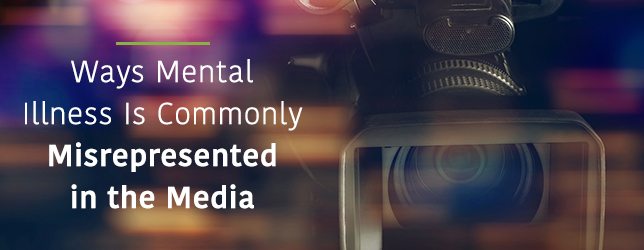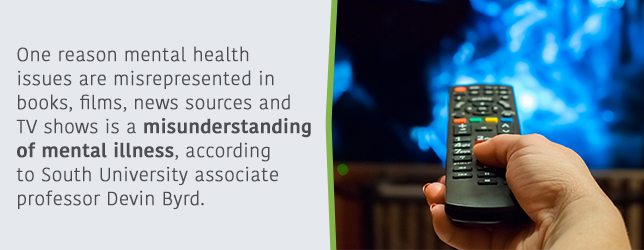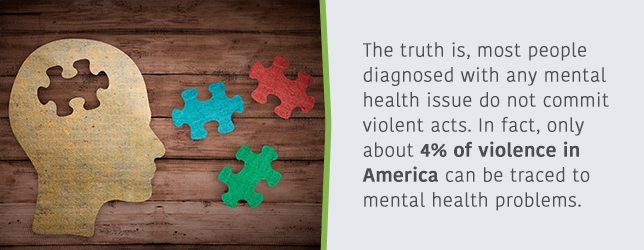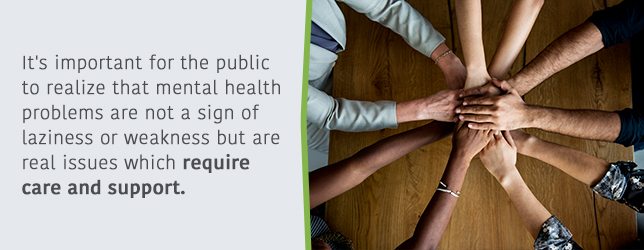Ways Mental Illness Is Commonly Misrepresented in the Media

When you think of how mental health issues are commonly portrayed in the media, what are the first images that come to mind? Do you think of a disheveled character running rampant in a small town or of a woman hearing voices as she plots revenge on her adulterous husband?
More often than not, the media portrays mental illness in a negative light, and this, in turn, affects the way we view mental illness, even as healthcare professionals. Many Americans rely on the media as their main source of information. A study conducted by the National Mental Health Association (NMHA) found that 70 percent of the public gets their information about mental health from the TV, 58 percent from newspapers, 51 percent from television news, 34 percent from news magazines and 25 percent from the internet.
Often, the information is inaccurate and creates a false picture of what mental illness really is. People are fed stereotypes that they believe are based on truth, when in fact, they are usually based on misunderstandings. These stereotypes lead to a stigma, which has a harmful effect on many individuals due to the following reasons:
- Discourage people from getting the help they need
- Make recovery more difficult because people feel less confident
- Promote discrimination in the workplace, school or any social situation
- Cause isolation because of fear
- Negatively impact friends, family and relationships
- Create the view that those who have a mental health problem are outsiders
- Damage self-image
The media has a lot of power, and media and healthcare professionals can work together to reduce the stigma attached to mental illness. Considering that an estimated one in five people experiences mental illness each year — the stigma needs to go away.
So, why are mental health issues misrepresented in the first place? How is mental illness misrepresented in the media, and what can be done about it? Let’s look at examples and work toward creating a more honest and accepting society together.
Why Are Mental Health Issues Misrepresented?
One reason mental health issues are misrepresented in books, films, news sources and TV shows is a misunderstanding of mental illness, according to South University associate professor Devin Byrd. Writers in the entertainment industry need to put more effort into depicting health issues accurately if they want to make a difference. However, sometimes writers misrepresent mental illness simply because it creates conflict in a story. And conflict is interesting — it’s what draws an audience in.
Sandra de Castro Buffington, director of the Hollywood, Health and Society Program, which strives to provide accurate information for entertainment professionals, says writers look for conflict to resolve, and “Mental health has a lot of conflict to resolve.”
So, while filmmakers intend to entertain their audience with inaccurate portrayals, they may be causing more harm than they realize. Millions of Americans have been diagnosed with mental health disorders, and stigmas discourage them from getting the help they need. They feel ashamed and choose to keep their problems to themselves.
Also, mental illness affects everyone differently. You do not have to look or act crazy, like the characters in films or TV shows, to experience the difficulty of mental health issues. Many Americans go to work or school hiding their pain for fear of the stigma attached to their condition. It does not need to be this way.
Despite the misrepresentations seen in the media, Americans continue to watch the films, shows and news programs that support such stigmas. For example, the film Shutter Island, released in 2010, and A Beautiful Mind, released in 2001, are both very popular films. Both films were analyzed for their depiction of schizophrenic protagonists. Here’s what was found:
- In Shutter Island, there were nine instances of violence with others and four instances of self-inflicted violence.
- In A Beautiful Mind, there were four instances of violence with others and three instances of self-inflicted violence.
What does this communicate to the audience? It says that people who had been diagnosed with schizophrenia are more violent than people who had not been diagnosed with schizophrenia — a stereotype based on inaccuracy rather than fact.
According to research published by the American Psychological Association (APA), out of the crimes committed by those with serious mental illness disorders, only 7.5 percent were directly related to mental illness symptoms. Schizophrenia, which is commonly misrepresented in the media, usually does not lead to violence. It is more common for drugs and alcohol to affect a person’s behavior than mental illness alone. Nevertheless, a 2006 survey found that 60 percent of Americans believe that people with schizophrenia are likely to act violently.
The truth is, most people diagnosed with any mental health issue do not commit violent acts. In fact, only about four percent of violence in America can be traced to mental health problems.
Mental illness is also portrayed in the news inaccurately. A recent example was the reaction to Nikolas Cruz, a man accused of a mass shooting in Florida in February 2018 and who has a history of mental health problems. In response to the tragedy, U.S. House of Representatives Speaker Paul Ryan said at a news conference, “Mental health is often a big problem underlying these tragedies.” Ryan’s view is not uncommon.
According to a 2017 CBS News poll, 68 percent of Americans feel better mental health screening would greatly help prevent gun violence. However, according to a book published by the APA, shootings by people with serious mental health issues represent less than one percent of all gun-related homicides each year.
Considering that 63 percent of Americans get a lot of their news from family and friends according to the Pew Research Center, and 46 percent of U.S. adults often get news from a TV source, it matters a lot what’s said and how it’s said. False information can easily form a stigma.
People may use stigmas to make sense of crimes they cannot otherwise understand. Stigmas allow us to cope with our own fears of the unknown and separate ourselves from the “others.” Understanding and knowledge can help bring light to the side of humanity we fear most.
What Are Common Misrepresentations of Mental Illness in the Media?
You’ve seen these stereotypes before in fictional characters, and you’ve likely heard or seen the following misrepresentations in the news or sources that are supposed to be accurate and trustworthy.
Don Diefenbach, a professor at the University of North Carolina, analyzed how mental illness is portrayed on TV. He found that characters with mental illness were ten times more likely to commit a violent crime than other characters and ten to twenty times more likely to commit a violent crime than someone with mental illness would in real life. Here are common media misrepresentations of mental illness most of us will recognize:
- They are violent: Mental illness is commonly the focus in the news as the primary cause for violent acts instead of considering other factors. The truth is, people with mental health problems are more likely to be victims of violent crime and less likely to commit them. In the film world, characters with mental health issues are often portrayed as unpredictably violent.
- They look different: You know the characters with crazy eyes or messy hair. They somehow look different or separate from “normal” people. In reality, people with mental health disorders look like ordinary people, not the stereotypes portrayed in the media.
- Mental health disorders are all the same, and they are all extreme: The media often generalizes mental illness and clumps all disorders in the same category. Also, severe mental illness is usually depicted in the media, but the majority of those who experience mental health issues do not experience extreme symptoms. For example, according to Diefenbach’s research, only seven percent of psychiatric disorders shown on TV was depression, and 12 percent was some form of psychosis. In reality, anxiety disorders are the most common mental illness in the United States, and major depressive disorder is the leading cause of disability. Anxiety and depression are often experienced together.
- They never recover: Characters with mental illness in films and TV shows rarely recover, and if they do, it is only temporary. This creates the belief that there is no hope for those who experience mental illness. In reality, therapy, medication and support from loved ones can greatly help with recovery from mental illness. Many people recover completely and can live productive, happy and healthy lives.
- Mental hospitals are evil: Although mental hospitals in the 18th century used physical treatments to “cure” mental illness, such as ice baths, the use of restraints and isolation, modern mental health facilities are not the dim, damp institutions controlled by malevolent doctors as often portrayed in books and films. Most people voluntarily choose to go to mental hospitals for help.
Some might see mental illness as a weakness of character, which may prevent someone from getting the help they need because they feel ashamed. However, mental illness is not something someone chooses or suffers from because they are weak. Many factors affect mental health, such as:
- Biology
- Physical illness
- History of abuse or trauma
- Family history
It’s important for the public to realize that mental health problems are not a sign of laziness or weakness but are real issues which require care and support.
What Can Be Done to Reduce the Stigma Attached to Mental Illness?
Because the media has the power to reinforce a stigma, media professionals need to take mental illness seriously and make an effort to dispel mental health myths. Mass media, which communicates with a large number of people, includes:
- Billboards
- News
- TV
- Films
- Radio
- Internet
Media professionals like journalists and filmmakers can help reduce mental health stigma by:
- Reporting responsibly and accurately
- Educating themselves and striving to portray the truth
- Considering the consequences of providing false information
- Meeting and connecting with real people who have been diagnosed with the disorders they wish to portray
- Approaching mental health with empathy and understanding
- Portraying mental health problems in a positive light
- Showing characters who recover
- Asking if mental health is relevant to the story
- Choosing language carefully
- Checking sources for accuracy
While not all of us are media professionals, anyone can help reduce the stigma attached to mental illness in the following ways:
- Praise the media and give positive feedback when they report good news
- Organize a mental health literacy campaign to educate the community about mental health and improve attitudes
- Protest and advocate with the goal to increase public awareness or initiate legislative reform
- Use social media to encourage positive attitudes and understanding
- Host community events to bring people with and without mental illness together
- Encourage open communication about mental health
- Educate yourself and others
- Be mindful of language used when discussing mental health
- Show compassion towards those with mental health problems
- Discourage shame and encourage empowerment, self-love and hope
- Write to media sources when they stigmatize mental illness and bring awareness to the situation
If you notice a media portrayal that is inaccurate or inappropriate, don’t be afraid to contact media sources and speak your mind. Look out for:
- Mocking of mental health issues
- Inaccuracy
- Misuse of medical terminology
- Glamorizing suicide
- Sensationalist reporting
- Inappropriate or demeaning language
How Can Mental Health Professionals Reduce Stigma?
Stigma in the workplace affects not only patients but healthcare workers as well. Fortunately, there are steps all healthcare professionals can take to reduce negative views of mental health issues so they can provide the best care possible for their patients. Likewise, it is important for healthcare professionals to address their own mental health problems without shame or embarrassment. The workplace will benefit overall from a positive attitude and a greater understanding of mental health.
Here are ways to help create a positive stigma-free work environment:
- Promote mental health in the workplace and raise awareness about mental health problems
- Encourage a help-seeking attitude
- Help patients overcome the stigma of mental illness by educating them
- Provide accurate and appropriate educational resources for employees and clients such as literature or videos, and organize conferences, community events or workshops
- Report and document accurate information
- Use video or contact-based educational sessions to connect the audience to people with mental health disorders
- Engage in public outreach and organize screenings
- Get help for yourself if you are experiencing mental health problems
- Attend anti-stigma training to address unconscious biases
- Practice optimism
- Ensure all employees are adequately trained
- Strive to dispel stigma among healthcare workers
- Teach behavioral and communication skills
- Be a leader and set positive examples
- Encourage workplace compassion and understanding
- Show ways healthcare providers have helped patients recover
- Listen to success stories regarding mental health and share your knowledge with employees
- Reach out to media sources and share your knowledge
- Contact media sources if you notice inaccurate or insensitive information
Request a Free Trial With ICANotes Today
ICANotes makes accurate documentation fast and easy for you and your employees, reducing the risk of sharing false information and helping you ensure your patients get the care they deserve. Developed by clinicians who understand what professionals and patients need, our EHR software is user-friendly, intuitive and requires very little training to get started. ICANotes helps healthcare professionals stay on track with proper documentation and with greater peace of mind. With less time spent on reports and insurance claims, you’ll have more time with your patients and your community.
Contact us today more information about the benefits of ICANotes Behavioral Health EHR or to start your free trial.
Related Posts:
How to Give Patients Access to Their Mental Health Records
Dispelling 8 Common Myths About Mental Illness
Most Common Industries Affected by Mental and Behavioral Health Issues




